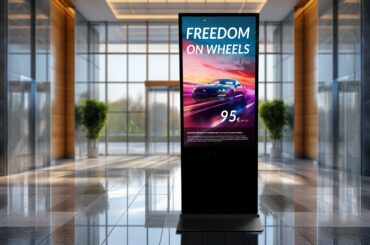What works indoors, should work outdoors, too. That sounds like it should be true, but in reality, it doesn’t always work out that way. Especially when it comes to Digital Signage. Because without the right technology, nothing works.
There are many possibilities when you want to use Digital Signage displays indoors and many places are already tapping into those successfully. Now let’s talk about how to make a lasting impression outdoors because a successful outdoor Digital Signage installation can have a big impact.
Just think, what would Times Square be without its bright led lights and colorful advertisements? Exactly, just a dark intersection. Thanks to outdoor Digital Signage displays, Times Square is the number one tourist attraction in the Big Apple.
If you have had great experiences with a Digital Signage solution in your store, and want to take the next step to install one outdoors, you should keep the following things in mind. If you are prepared, you will be successful despite heat, rain, wind or vandalism.
1. Ambient light
Digital Signage solutions that are installed inside have the advantage of almost consistent surroundings. Of course, this all changes when you step outside.
No two days are the same, at least not here in Europe. You can see this especially when it comes to the lighting conditions, which change multiple times in just one day.
They don’t just differ between sunrise and sundown but also depending on the season. The sun shines brighter on a nice summer day than on a dark winter day.
Despite these changing conditions we expect our outdoor Digital Signage display to deliver the same output every day – a clear, steady image with bright colors and great contrast.
To make this a reality it is important that the screens for outdoor digital signage have the necessary performance. The most important aspect is the luminosity, which is measured in nits.
For an indoor installation, you use regular screens with up to 350 nits. For a luminous outdoor installation, you should use screens with a luminosity of 2000 nits. The surrounding light is measured with built-in sensors so that the screens can adapt their luminosity automatically.
This means that they can shine brighter when there is a lot of light or tone down their luminosity when it is darker. As a side effect, the screen also saves energy this way, because it only uses the power it really needs.
2. Climate
Next to changes in lighting conditions there can be changes in the climate, too. The classic example is the different seasons.
Outdoor installations have to brave any kind of weather. Storms, rain, hail, or heat can be pretty common, depending on where you are, and can ask a lot of your installation.
If you live in an area that is known to have strong winds, it is also important to make sure that your installation is fixed properly to the floor. Or if you are located in an area where there is a lot of rain, the signs have to be protected from getting wet, or they may rust.
If you live in the south and have hot summers, you have to keep in mind that the strong sun can lead to black spots on your displays.
To address all of these different issues resulting from different weather conditions, most screens are being offered with an appropriate housing or case.
This basically creates its own climate within the installation: if it’s hot, it cools itself down, if it’s cold, it heats itself up – allowing devices to be used between -40 F and + 122 F.
This covers most regions. The glass of the housing should also include a UV filter to make sure that incoming sunlight doesn’t damage the displays. Thanks to the IP65 certificate, the cases protect the displays from water and dust and prolong their lifespan in your outdoor area.
3. Vandalism and other dangers
It is not only the weather that has an impact on outdoor Digital Signage displays. Sadly, they can also be targets of random acts of violence.
To protect your devices from vandalism and theft, you should choose a casing that doesn’t just shield your screens from the weather, but also from damage.
We recommend a robust casing with protective glass, that is fixed firmly so that it cannot be stolen.
If you want to install your display close to trams and train stations, you should keep in mind that the rail traffic creates vibrations. This is isn’t a big deal for us, but the delicate technology inside the screens can be damaged quickly by them.
You should definitely get a consultation before installing an outdoor Digital Signage display under those conditions.
4. Connection
Most Digital Signage providers advertise the easy handling of their products thanks to plug&play.
For this technology to work, two important components have to present: power and a strong internet connection.
This is usually not an issue indoors because WiFi and power outlets are always available. But outside is a totally different ballgame.
This is a problem especially when you want to place a display outside of the existing infrastructure of a city, for example on a field or next to a highway. It is important to find out beforehand if there are existing connections that can be used so your installation can have access to these important aspects.
5. Sometimes less is more
To install the least amount of hardware components, we recommend using a display with SoC (System on Chip) for an outdoor Digital Signage solution.
In this case, the monitor already has a built-in chip, that has an already installed Content Management system.
Alternatively, you can install a Digital Signage Software via an internet connection. The chip also has storage for up to 4 or 8 GB, so you can manage and change the content of your installation without having to install more hardware.
This saves space and energy. It also means that it is easier to set-up and gets started, and you have no issues with the compatibility between software and hardware components.
If you keep these things in mind when you plan for your outdoor Digital Signage application, nothing will stand in the way of a successful installation. The market space is rapidly developing, so take this chance to have the early bird be at home on your display.





